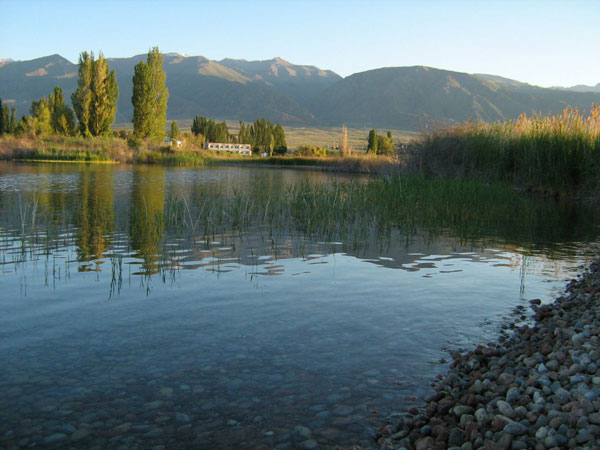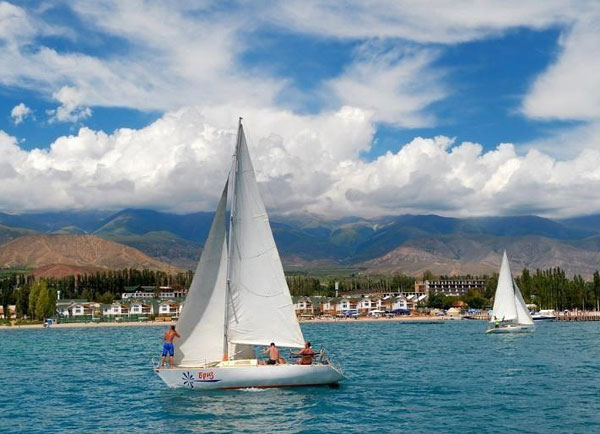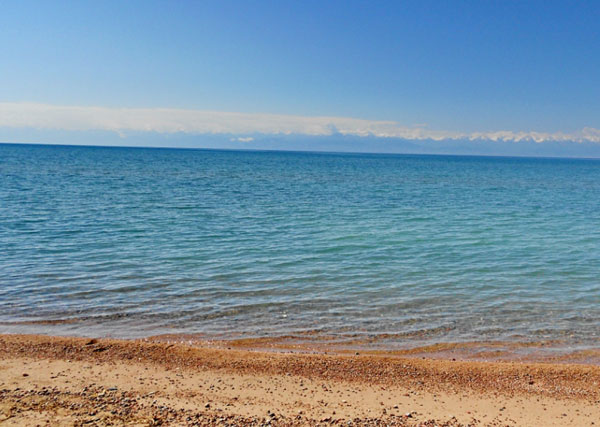Issyk-Kul (also Ysyk Köl, Issyk-Kol: Kyrgyz: Ысык-Көл, Isıq-Köl/Ysyk-Köl, ىسىق-كۅل, [ɯsɯqkœl]; Russian: Иссык-Куль) is an endorheic lake in the northern Tian Shan mountains in eastern Kyrgyzstan. It is the tenth largest lake in the world by volume (though not in surface area), and the second largest saline lake after the Caspian Sea. Issyk-Kul means "warm lake" in the Kyrgyz language; although it is surrounded by snow-capped peaks, it never freezes.
The lake is a Ramsar site of globally significant biodiversity (Ramsar Site RDB Code 2KG001) and forms part of the Issyk-Kul Biosphere Reserve.
Issyk-Kul Lake is 182 kilometres (113 mi) long, up to 60 kilometres (37 mi) wide, and its area is 6,236 square kilometres (2,408 sq mi). It is the second largest mountain lake in the world behind Lake Titicaca in South America. It is at an altitude of 1,607 metres (5,272 ft), and reaches 668 metres (2,192 ft) in depth.
About 118 rivers and streams flow into the lake; the largest are the Djyrgalan and Tyup. It is fed by springs, including many hot springs, and snow melt. The lake has no current outlet, but some hydrologists hypothesize[6] that, deep underground, lake water filters into the Chu River. The bottom of the lake contains the mineral monohydrocalcite: one of the few known lacustrine deposits.
The lake's southern shore is dominated by the ruggedly beautiful Teskey Ala-Too Range of the Tian Shan mountains. The Kungey Alatau of the Tian Shan runs parallel to the north shore.
The lake water's salinity is approx. 0.6%— compared to 3.5% salinity of typical seawater— and, although the lake level is still currently some 8 metres (26 ft) higher than in medieval times, its level now drops by approximately 5 cm per year due to water diversion.
Administratively, the lake and the adjacent land are within Issyk-Kul Region of Kyrgyzstan.
Tourism
During the Soviet era, the lake became a popular vacation resort, with numerous sanatoria, boarding houses and vacation homes along its northern shore, many concentrated in and around the town of Cholpon-Ata. These fell on hard times after the break-up of the USSR, but now hotel complexes are being refurbished and simple private bed-and-breakfast rentals are being established for a new generation of health and leisure visitors.
The city of Karakol (formerly Przhevalsk, after the Russian explorer Przhevalsky who died there) is the administrative seat of Issyk-Kul Region of Kyrgyzstan. It is near the east tip of the lake and is a good base for excursions into the surrounding area. Its small old core contains an impressive wooden mosque, built without metal nails by the Dungan people, and a wooden Orthodox church that was used as a stable during Soviet times (see state atheism).
History
Nestorian tombstone with inscriptions in Uyghur, found in Issyk-Kul, dated 1312
Issyk-Kul Lake was a stopover on the Silk Road, a land route for travelers from the Far East to Europe. Many historians believe that the lake was the point of origin for the Black Death that plagued Europe and Asia during the early and mid-14th century.[9] The lake's status as a byway for travelers allowed the plague to spread across these continents via medieval merchants who unknowingly carried infested vermin along with them.
On the beach at Koshkol'
The lake level is some 8 metres (26 ft) higher than in medieval times. Divers have found the remains of submerged settlements in shallow areas around the lake. In December 2007, a report was released by a team of Kyrgyz historians, led by Vladimir Ploskikh, vice president of the Kyrgyz Academy of Sciences, that archaeologists have discovered the remains of a 2500-year-old advanced civilization at the bottom of the Lake. The data and artifacts obtained suggest that the ancient city was a metropolis in its time. The discovery consisted of formidable walls, some stretching for 500 metres (1,600 ft) and traces of a large city with an area of several square kilometers. Other findings included Scythian burial mounds eroded over the centuries by waves, and numerous well-preserved artifacts, including bronze battleaxes, arrowheads, self-sharpening daggers, objects discarded by smiths, casting molds, and a faceted gold bar that was a monetary unit of the time.
Articles identified as the world's oldest extant coins were also found underwater with gold wire rings used as small change and a large hexahedral goldpiece. Also found was a bronze cauldron with a level of craftsmanship that is today achieved by using an inert gas environment.
In 1916 the monastery at Issyk Kul was attacked by Kyrgyz rebels, and seven monks were killed












